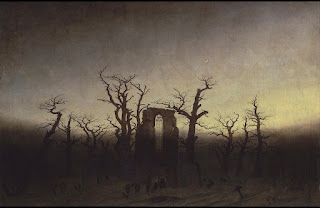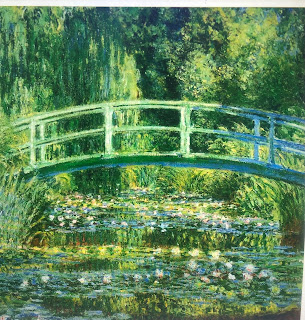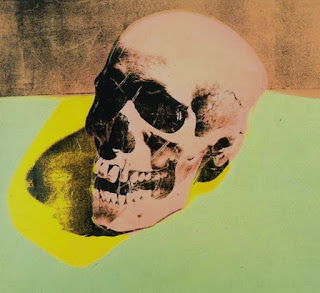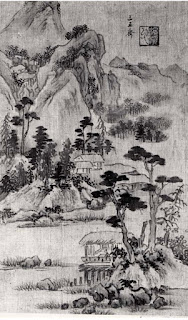Romantic Era
Romanticism is a type of art where the artist emphasized that sense and emotions - not simply reason and order - were equally important means of understanding and experiencing the world. Romanticism celebrated the individual imagination and intuition in the enduring search for individual rights and liberty. A popular technique that Romantic painters used was small, close strokes of complementary colors.
 |
| “Abbey among Oak Trees, Caspar David Friedrich” |
Friedrich painted “Abbey among Oak Trees” in 1809 through 1810 in Dresden. This is an example of romanticism because you get the feeling of sadness and desolation. The sun is going down behind the horizon as fog emerges the ground. The dead trees rise above the fog and surrounds the crumbling ruins of a gothic abbey. A sense of terror overcomes the landscape as a funeral takes place. This painting captures many themes that are part of Romanticism. For example the color palette is muted tones of yellow and grey. I would absolutely own a copy of this art. I love the creepy vibes that you get from looking at this painting. I tend to love the darker types of art so the grave scene and Friedrich’s use of dark colors, really draws my attention.
 |
| “ Stonehenge, John Constable” |
The second painting I picked is by John Constable called “ Stonehenge” it was painted in 1835 and is currently in London and the Victoria and Albert Museum. Constable painted this watercolor at a sad time in his life. His wife and close friend died and his two oldest sons left home. He is perhaps trying to express his personal unhappiness in the watercolor. The deep blues and purples help portray the feelings of sadness while the brush strokes look almost erratic. This is an example of Romanticism because it’s heavy on nature and emotional play. While he did use dark colors in the sky, the bottom of the painting is more cool tones of yellow and green. His way of painting the sky with the rough brush strokes almost makes you feel like it’s going to heaven or coming down from heaven. This is another piece I’d love to add to my art collection. I love the raw emotion you see and feel while looking at the painting. I think one reason I love it so much is because of the brush strokes. I picture him sitting in front of the canvas, pain etched on his face and just letting his emotions out with each brush stroke. The top part is all the pain and chaos while the bottom part is more peaceful.
The second type of art I’m gonna talk about is impression. Impression is an art form that has multiple characteristics. The artist usually does not focus on harsh lines and shapes, the paintings often appear slightly out of focus. And the artist aims to convey the object or place at a specific moment in time.

“Water Lillies and Japanese Bridge, Claude Monte”
Claude Monte painted “ Water Lillies and Japanese Bridge in 1899 in France. The inspiration behind this piece is from his actual property he bought in 1890. This painting is a vibrant mix of greens and blues, punctuated with whites and pale pinks of the flowers. The reflection of the willows and foliage surrounding the pond completely fills the water, potentially leading the viewer, who may have quickly glanced at it, to wonder why the bridge is over greenery and not water. Monte’s brush strokes are soft and short, leading the viewers to not be able to see where he started and stopped. The painting is an example of impression because how it’s slight out of focus by the use of his brush strokes. I would be open to having this art piece because of the emotions it conveys. I get a sense of peace and comfort by looking at it.
Vincent Van Gogh painted the “ Starry Night” in 1889 during his stay at the asylum of Saint-Paul-de-Mausole in France. Van Gogh’s vision took place at night, yet the painting was created in several sessions during the day. Van Gogh assigned an emotional language to night and nature that took them far from their actual appearances. This is an example of impression for many reason. One if you notice the brush strokes. For the sky they swirl, each color rolls with the clouds around the moon and stars. On the tree the bend with the curve of the branches. The painting also can be considered out of focus as well because of the brush stokes and patterns. The Starry Night is by far my favorite art piece. I have a few different copies of it and could look at it all day long. One reason it’s my favorite, is the story behind it. I love that it was done while Van Gogh was dealing with mental issues. It always makes me remember that no matter how bad your life is, something beautiful can still come out of it. 
“ The Starry Night, Vincent Van Gogh”
Romanticism vs Impression
Romanticism is characterized by complex compositions that emphasize the natural world, explore the connections between human and nature, and delve into themes of individuality and human liberty. Romantic paintings often incorporate nature, including scenery and weather like storms, to evoke mood and atmosphere. For example, my first painting I talked about is a grave yard that’s dark and creepy. Impressionism , compared to Romanticism focuses of giving the impression of light and movement in paintings as opposed to evoking emotional responses (Comparing Romanticism and Impressionism in Art). Impression art also tends to avoid too much details and is done by capturing a moment in time. Example, the two paintings I choose were both painted from scenes the artist have witnessed.
Comparing Romanticism and Impressionism in Art, study.com/academy/lesson/comparing-romanticism-and-impressionism-in-art.html. Accessed 26 Mar. 2024.
Dr. Steven Zucker and Dr. Beth Harris, et al. “Caspar David Friedrich, Abbey in the Oak Forest.” Smarthistory, smarthistory.org/caspar-david-friedrich-abbey-in-the-oak-forest/. Accessed 26 Mar. 2024.
French, Claude Monet. “Claude Monet: Bridge over a Pond of Water Lilies.” The Metropolitan Museum of Art, 1 Jan. 1899, www.metmuseum.org/art/collection/search/437127.


Hello Kelsey, I agree with your thoughts on Romanticism and Impressionism. The way you delve into Friedrich's "Abbey among Oak Trees" and Constable's "Stonehenge" is both captivating and deeply empathetic. The way you connect with the darker, more emotive aspects of these paintings shows your artistic sensibilities. Also, your exploration of Impressionism, particularly through Monet's "Water Lilies and Japanese Bridge" and Van Gogh's "Starry Night," showcases your keen eye for detail and appreciation of the fleeting moments captured by these masters. Thank you for sharing.
ReplyDeleteThis comment has been removed by the author.
ReplyDeleteHi Kelsey, The pictures that you chose really captivated me. The styles are between a dark feeling and then a lighter feeling. I think I would choose the Impression it always caught my eye when im looking at art. These two styles were widely different and you connected them both so well diving into each specific painting and background of each. Your attention to detail of all four paintings especially John Constable Stonehenge i would have never thought of him as expressing his unhappiness through watercolor since the colors in between happy and sad but i got a better understanding of it.
ReplyDelete
ReplyDeletehttps://kelsedbrown03.blogspot.com/2024/03/romantic-era.html
I like all four of these paintings but would only put two in my house. The “Abbey Among the Oak Trees” is creepy with the dead trees and a funeral taking place. This would be perfect Halloween decor. I would not put this in my house except for that ONE day. Any other time I would be looking over my shoulder wondering if one of the people in the painting was following me around the room with their eyes.
I was curious why the artist would be compelled to paint such sad, dark events. A little research revealed that he experienced the loss of his mother at the early age of seven. Later he witnessed his brother drown when he fell through the ice on a frozen lake, and then his sister died of typhus when he was only seventeen. That is a tremendous amount of grief for such a young person to experience.
I like the Stonehenge painting for the strong brush strokes of deep blue and the peacefulness reflected with the yellow color of the stones. It is as if this were the aftermath of a great storm, the sky is just beginning to clear, and the stones are laying at peace.
I would have the Water Lilies and Japanese Bridge along with Starry Night by Van Gogh in my house. I have had a love for Japanese bridges and lilies from my frequent visits to the Japanese Tea Gardens in San Francisco as a young girl. The water lilies and Japanese bridge are beautiful and peaceful with the blues and greens of the surrounding foliage and pink and white color of the lilies. I can easily imagine that may have been one of the reasons the artist purchased the property.
I would also like to have Van Gogh’s Starry Night. I do know he did this painting while experiencing mental health problems, but I have always wondered if he was imagining what it might look like if the falling stars were to make fantastic paths of light behind them while travelling the night sky. That could have been his equivalent of the time-lapse photography that we have today.